Abstract
A fluorimetric assay has been used to determine the DNA content of amoebae of Dictyostelium discoideum during growth and development. Amoebae grown in axenic culture tended to be multinucleate and had a greater DNA content than amoebae grown with a bacterial substrate, which were mononucleate. During the first 10 h of development there was little change in the DNA content of amoebae grown with a bacterial substrate, but the average DNA content per cell in amoebae grown axenically decreased as the amoebae became virtually mononucleate. Amoebae at 10 h development that had been harvested during exponential axenic growth were divided into two populations by countercurrent distribution in a polymer two-phase system. DNA content indicated that one population was largely in the G2-phase of the cell cycle, whereas the other population was largely in the G1-phase. Similar results were obtained at 10 h development with amoebae harvested during the stationary phase of axenic growth, although these amoebae start development all in the G2-phase of the cell cycle. Spores had a low DNA content, indicating that they were in G1-phase. It is proposed that all amoebae in G2-phase after early development differentiate, after mitosis, into spores and that stalk cells are formed from amoebae that remain in G1-phase after 10 h development.
Full text
PDF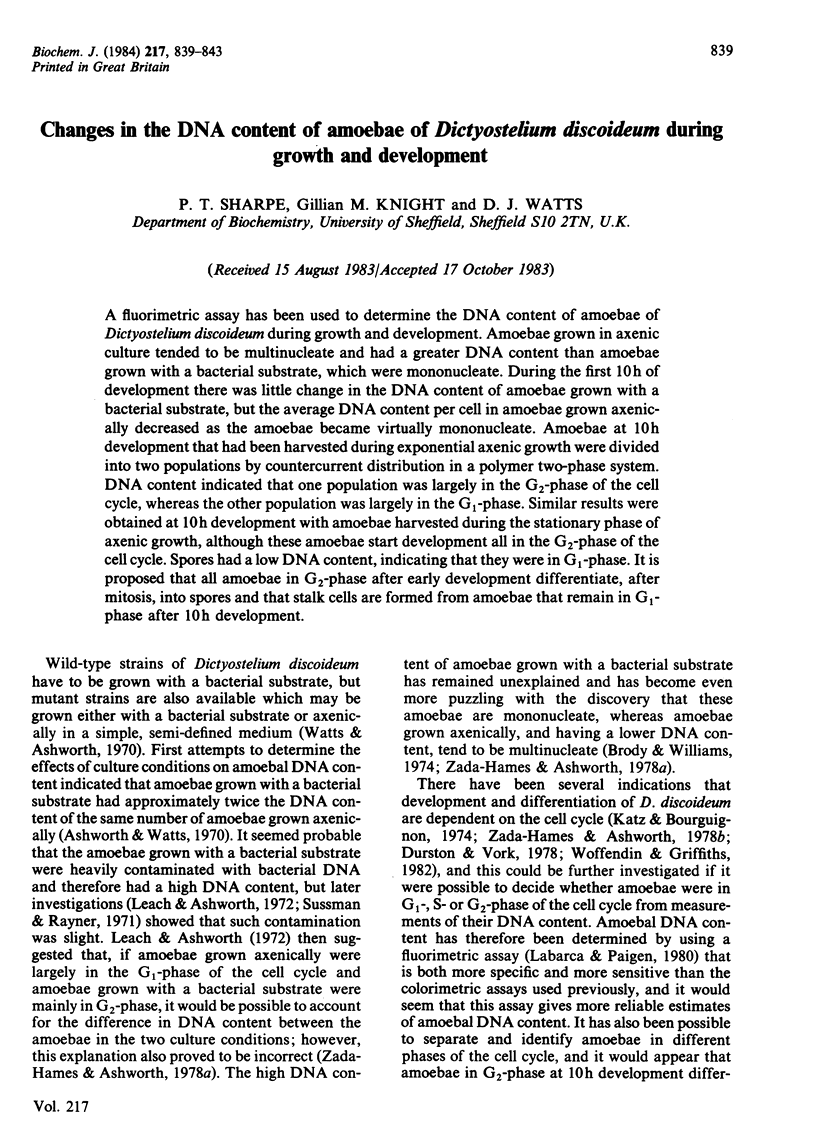
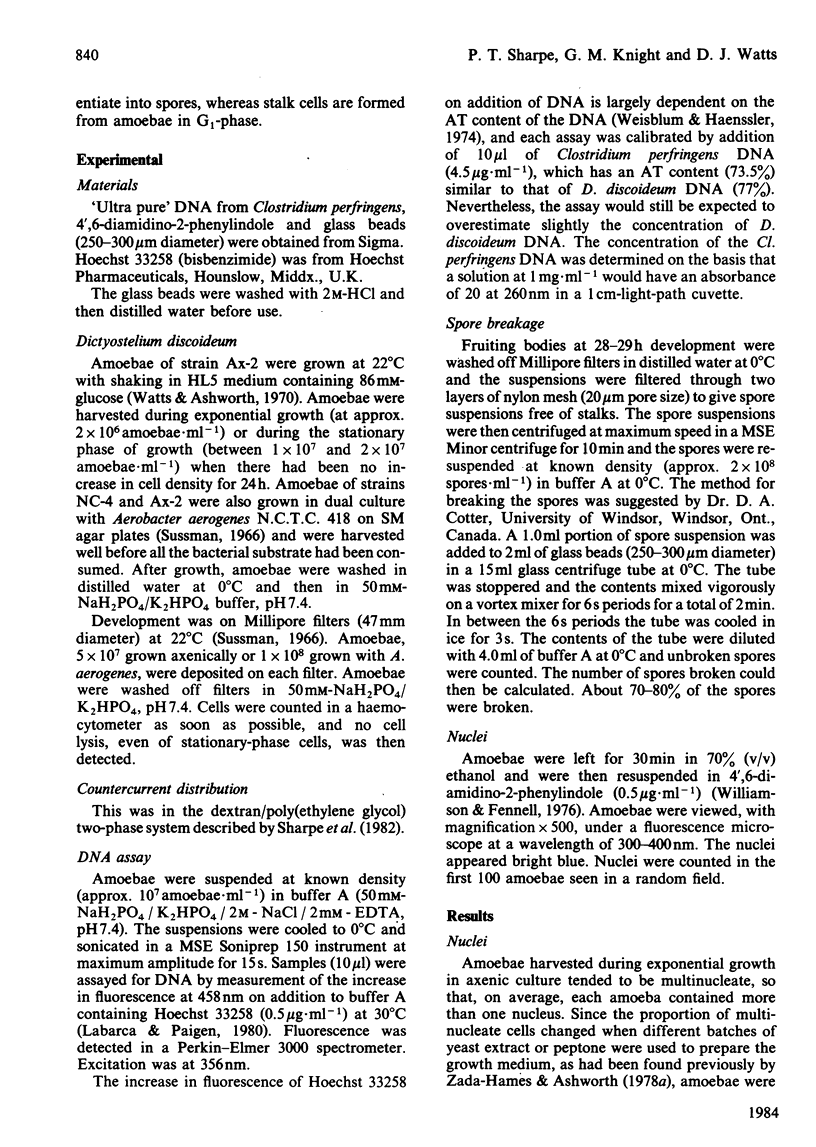
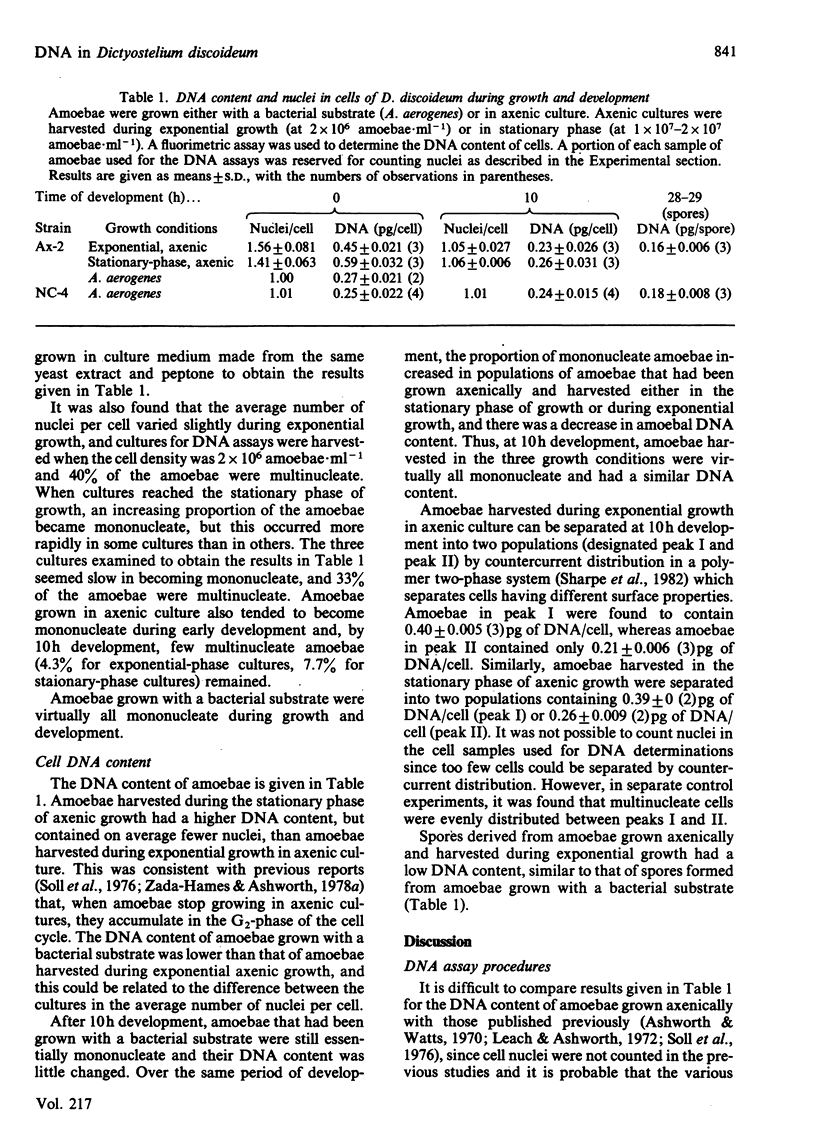
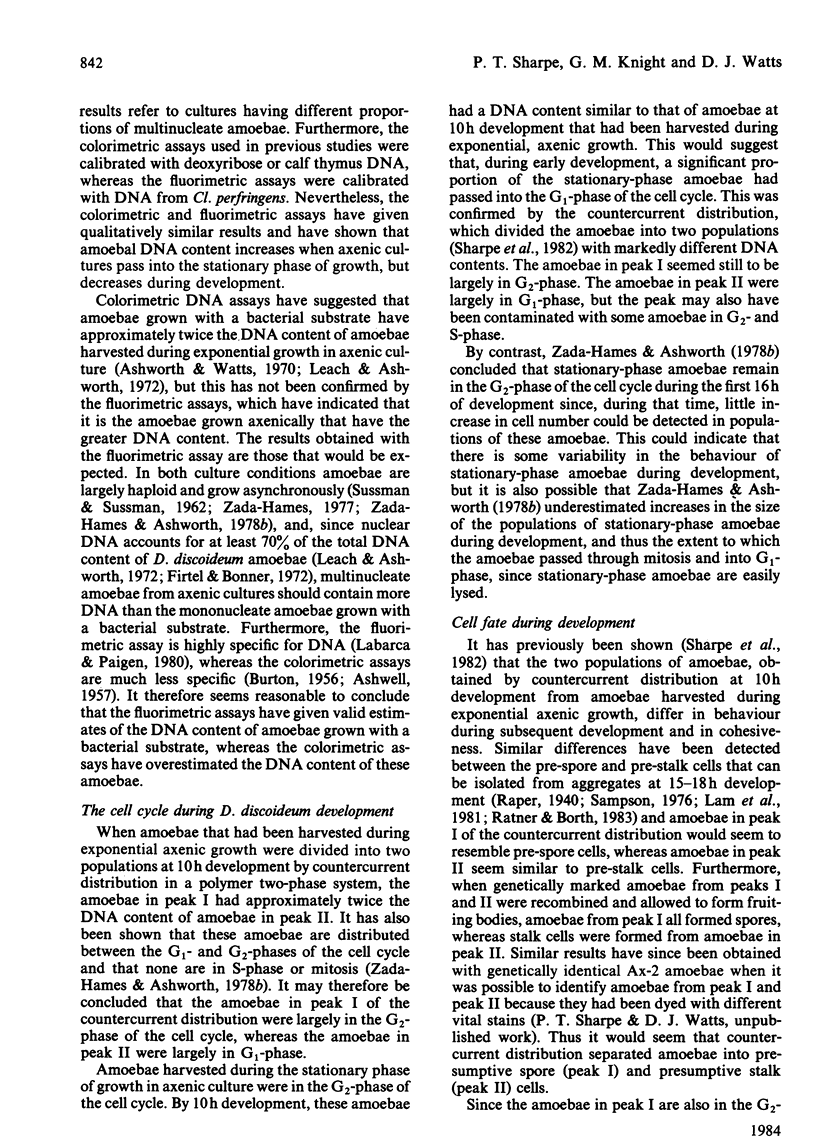
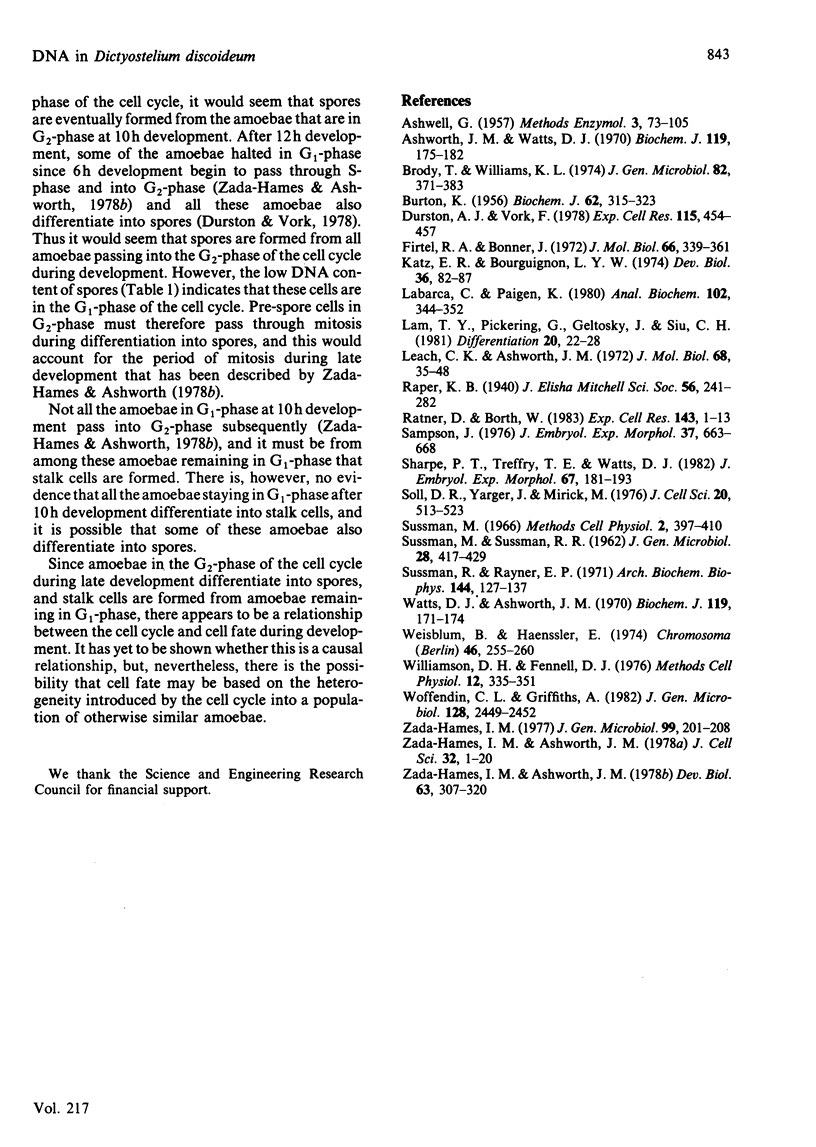
Selected References
These references are in PubMed. This may not be the complete list of references from this article.
- Ashworth J. M., Watts D. J. Metabolism of the cellular slime mould Dictyostelium discoideum grown in axenic culture. Biochem J. 1970 Sep;119(2):175–182. doi: 10.1042/bj1190175. [DOI] [PMC free article] [PubMed] [Google Scholar]
- BURTON K. A study of the conditions and mechanism of the diphenylamine reaction for the colorimetric estimation of deoxyribonucleic acid. Biochem J. 1956 Feb;62(2):315–323. doi: 10.1042/bj0620315. [DOI] [PMC free article] [PubMed] [Google Scholar]
- Durston A. J., Vork F. The spatial pattern of DNA synthesis in Dictyostelium discoideum slugs. Exp Cell Res. 1978 Sep;115(2):454–457. doi: 10.1016/0014-4827(78)90308-7. [DOI] [PubMed] [Google Scholar]
- Firtel R. A., Bonner J. Characterization of the genome of the cellular slime mold Dictyostelium discoideum. J Mol Biol. 1972 May 28;66(3):339–361. doi: 10.1016/0022-2836(72)90419-6. [DOI] [PubMed] [Google Scholar]
- Katz E. R., Bourguignon L. Y. The cell cycle and its relationship to aggregation in the cellular slime mold, Dictyostelium discoideum. Dev Biol. 1974 Jan;36(1):82–87. doi: 10.1016/0012-1606(74)90192-4. [DOI] [PubMed] [Google Scholar]
- Labarca C., Paigen K. A simple, rapid, and sensitive DNA assay procedure. Anal Biochem. 1980 Mar 1;102(2):344–352. doi: 10.1016/0003-2697(80)90165-7. [DOI] [PubMed] [Google Scholar]
- Leach C. K., Ashworth J. M. Characterization of DNA from the cellular slime mould Dictyostelium discoideum after growth of the amoebae in different media. J Mol Biol. 1972 Jul 14;68(1):35–48. doi: 10.1016/0022-2836(72)90260-4. [DOI] [PubMed] [Google Scholar]
- Ratner D., Borth W. Comparison of differentiating Dictyostelium discoideum cell types separated by an improved method of density gradient centrifugation. Exp Cell Res. 1983 Jan;143(1):1–13. doi: 10.1016/0014-4827(83)90103-9. [DOI] [PubMed] [Google Scholar]
- Sampson J. Cell patterning in migrating slugs of Dictyostelium discoideum. J Embryol Exp Morphol. 1976 Dec;36(3):663–668. [PubMed] [Google Scholar]
- Soll D. R., Yarger J., Mirick M. Stationary phase and the cell cycle of Dictyostelium discoideum in liquid nutrient medium. J Cell Sci. 1976 May;20(3):513–523. doi: 10.1242/jcs.20.3.513. [DOI] [PubMed] [Google Scholar]
- Sussman R., Rayner E. P. Physical characterization of deoxyribonucleic acids in Dictyostelium discoideum. Arch Biochem Biophys. 1971 May;144(1):127–137. doi: 10.1016/0003-9861(71)90462-0. [DOI] [PubMed] [Google Scholar]
- Watts D. J., Ashworth J. M. Growth of myxameobae of the cellular slime mould Dictyostelium discoideum in axenic culture. Biochem J. 1970 Sep;119(2):171–174. doi: 10.1042/bj1190171. [DOI] [PMC free article] [PubMed] [Google Scholar]
- Weisblum B., Haenssler E. Fluorometric properties of the bibenzimidazole derivative Hoechst 33258, a fluorescent probe specific for AT concentration in chromosomal DNA. Chromosoma. 1974;46(3):255–260. doi: 10.1007/BF00284881. [DOI] [PubMed] [Google Scholar]
- Williamson D. H., Fennell D. J. The use of fluorescent DNA-binding agent for detecting and separating yeast mitochondrial DNA. Methods Cell Biol. 1975;12:335–351. doi: 10.1016/s0091-679x(08)60963-2. [DOI] [PubMed] [Google Scholar]
- Zada-Hames I. M., Ashworth J. M. The cell cycle and its relationship to development in Dictyostelium discoideum. Dev Biol. 1978 Apr;63(2):307–320. doi: 10.1016/0012-1606(78)90136-7. [DOI] [PubMed] [Google Scholar]
- Zada-Hames I. M., Ashworth J. M. The cell cycle during the vegetative stage of Dictyostelium discoideum and its response to temperature change. J Cell Sci. 1978 Aug;32:1–20. doi: 10.1242/jcs.32.1.1. [DOI] [PubMed] [Google Scholar]


